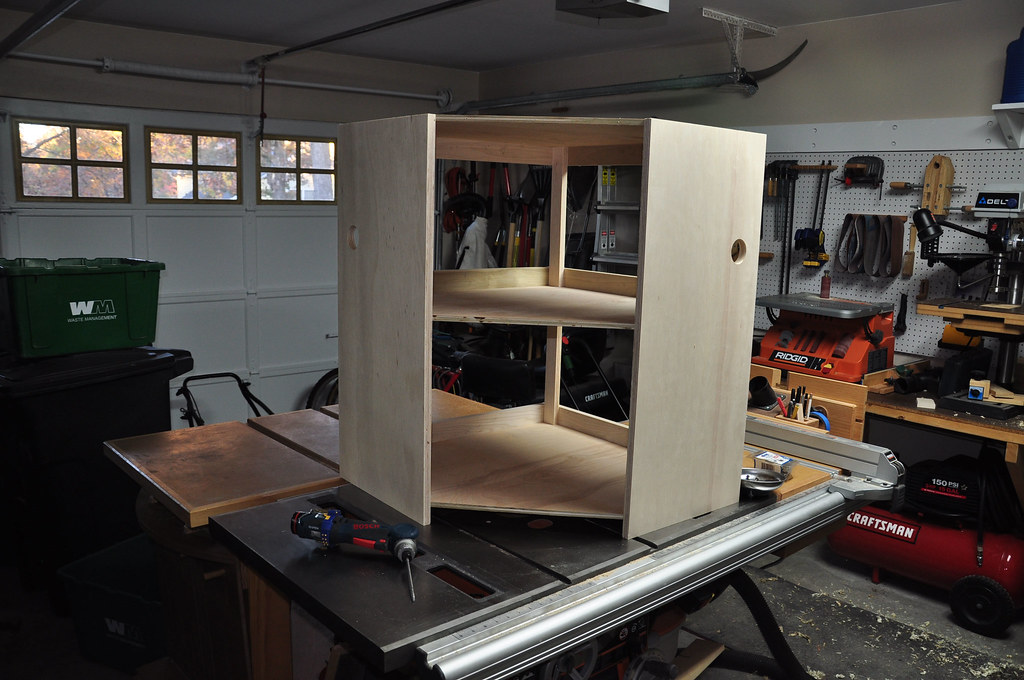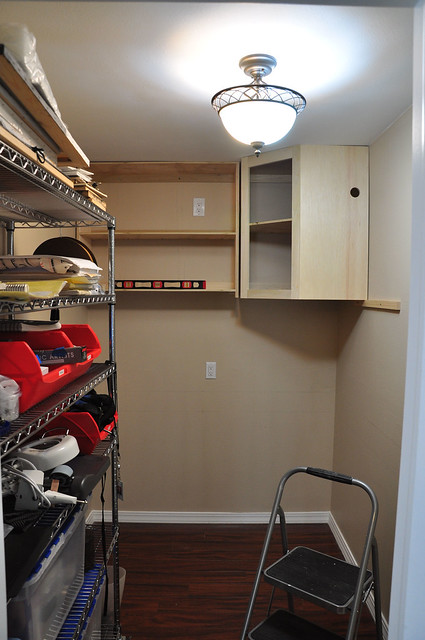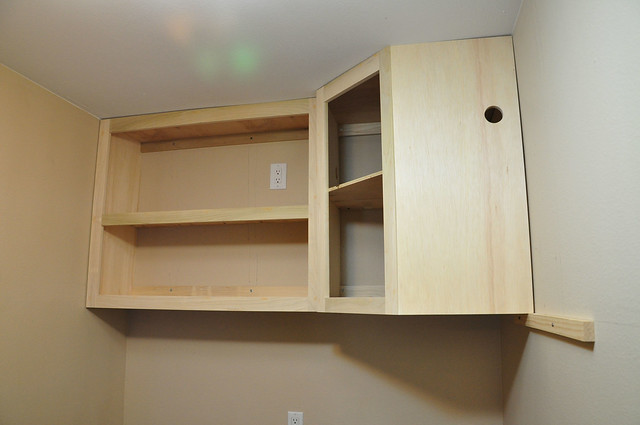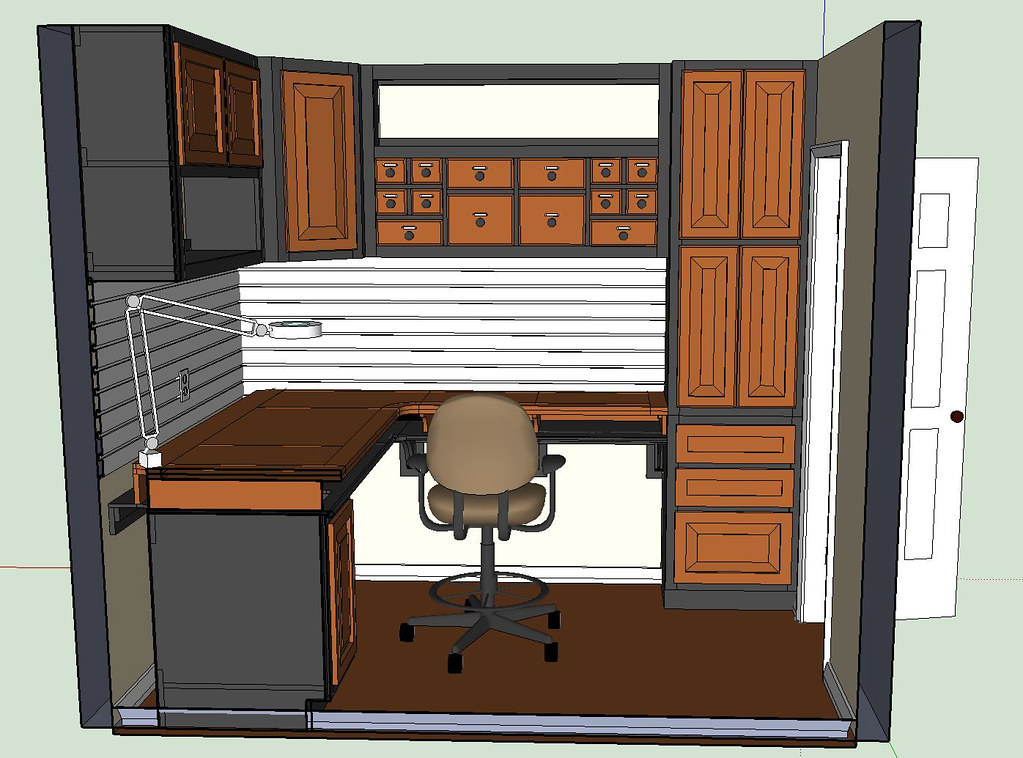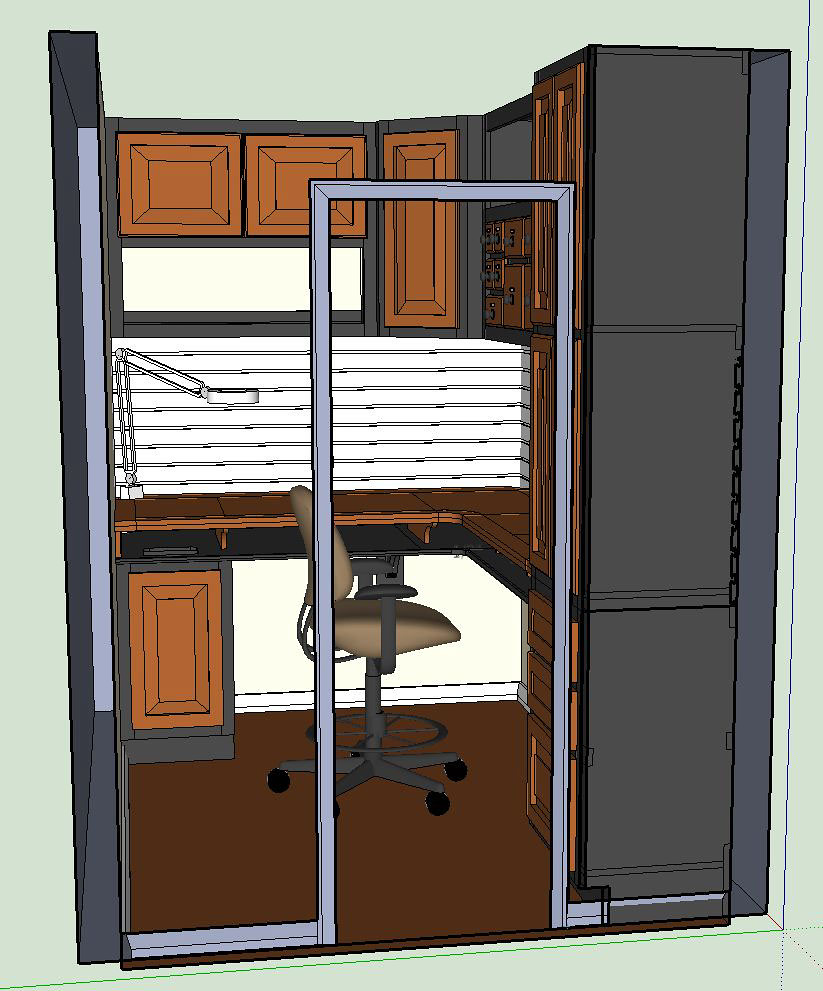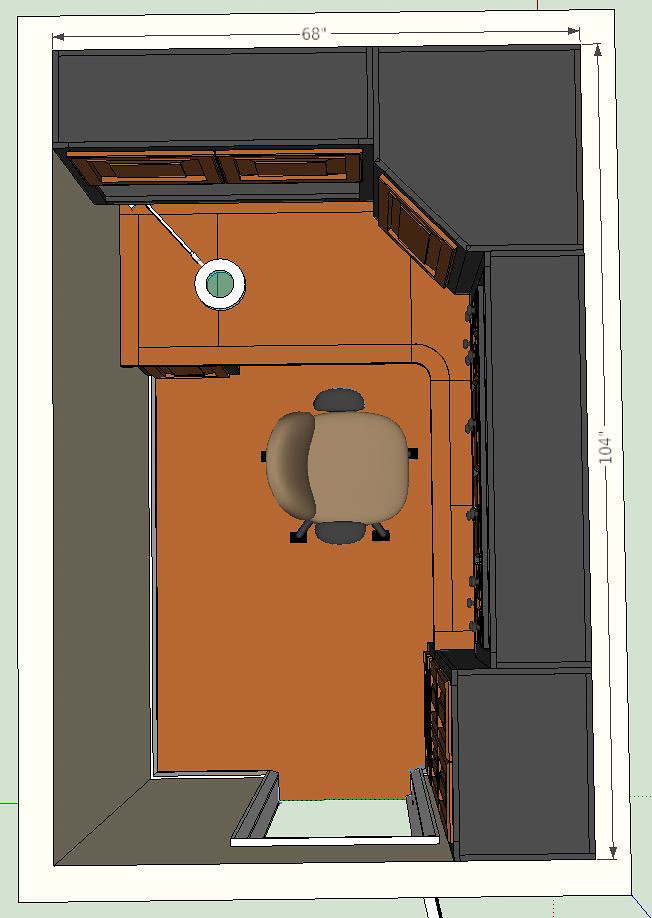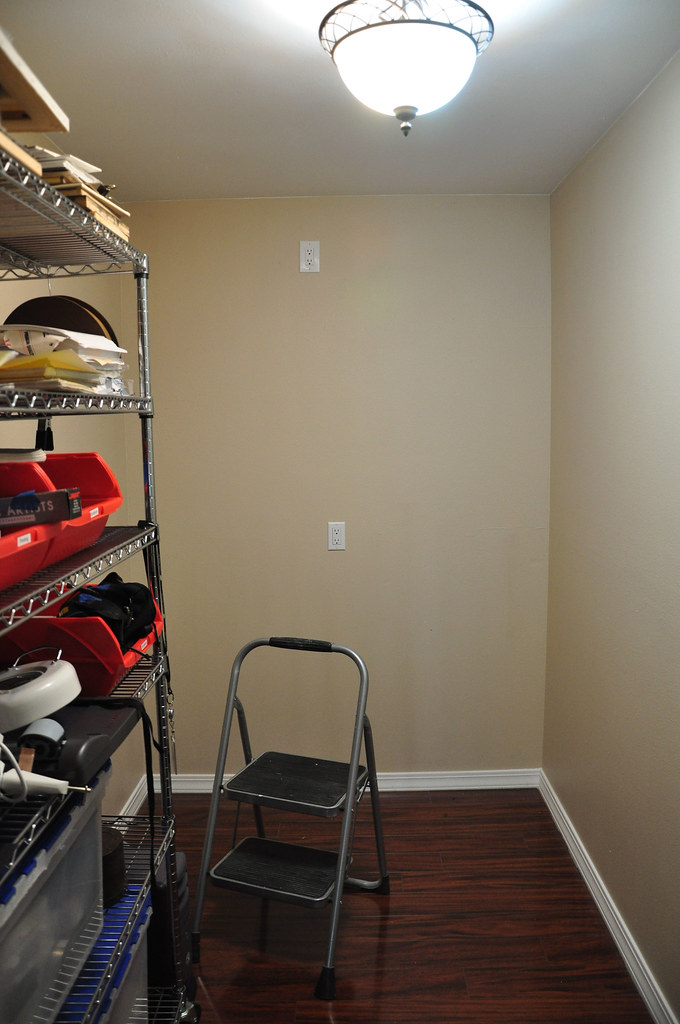This post is third in a series outlining my Art Room Project. Find the Table of Contents at the first post, Getting Started.
Time to Build
I've never built a cabinet before. The most I've made to this point are some small shelves and cubby holes for a closet. Before I started cutting, however, I felt confident I would be successful, mostly because of my work in SketchUp doing the designs. I already built the entire project digitally. I knew what size every board and panel should be and where they should go.
Materials
I wanted to use materials easy to find (and replace if I screw up) in my area, so I decided on a motley mixture of Birch plywood (3/4" and 1/2") for cabinet carcass, 3/4" poplar for face frame and trim, and 3/4" red oak for doors and drawer fronts. Since I planned on the two-tone look, I could get away with mixing the wood types.
Expected Issues
The only issues I had to overcome were the reality issues all carpenters must master, such as: walls not being level, rooms not being square, not all 3/4" boards being 3/4", seasonal wood sizing, etc. In my little experience, I knew I had to work around these problems rather than trying to solve them. The best way to do this was to build in stages, starting with the immutable parts first, and adapt where I could.
Start in the Corner
I started with the top corner cabinet for this reason. It was big and bulky and it's shape couldn't be adapted easily, whereas the shelves could easily be adjusted to fit the remaining space.
The basic corner cabinet was relatively easy. The holes in the side and selves are for under cabinet lighting and wiring options later.
Hang Time
And now it is time to install. Corner cabinet up first, then I checked the measurements for the shelves and adjusted accordingly.
We're off to a good start! Everything is level and secure. The face frame is on. Time to move to the big, side cabinet next.
Next Post: Side Cabinets
Saturday, November 20, 2010
Saturday, November 13, 2010
Art Room Project - Plans
This is the second post in my Art Room Project. Find the Table of Contents at the first post, Getting Started.
Decide to Design
I had many options to fill this small room and make it useful. I could just buy a desk and put up shelves, hire a cabinet maker to design and build, or continue to use the card table and wire shelves already in there. Once I decided to do the designing and building myself (carpentry is yet another hobby), I had to have a good way to visualize what I wanted.
SketchUp
I studied many design applications and chose Google SketchUp. The application is free, easy to use, and after going through all their tutorials and some testing on my own, I felt SketchUp would work great. With some minor setup, it can be adapted to do woodworking plans.
Note: Fine Woodworking has an entire blog on the SketchUp here.
It shows the upper cabinet with open shelves, a corner cabinet, and smaller project drawers. These drawers can be easily removed when in use. I call them my "Project Drawers" because I plan on keeping like things in each drawer. For example, when painting, I'll pull out the paint drawers with all the paints and supplies, put them on the desk and work away.
Another detail is in the desk. It doesn't go all the way back on the large side. There is a 3.5" gap to the wall where it drops down to the lower desk below. I took this idea from old wood working benches with the tool trough. I can put an electrical strip there and run wires under the main desk top. I can also put in any organizers I might need.
Front View, with wall invisible.
The desk is a double layer, with about a 3" gap. This is for flat file storage, running wires and other things. There is slatwall between the desk and upper cabinets so I can hang shelves or other organizers. The small cabinet on the left holds a trash can.
Top View
Decide to Design
I had many options to fill this small room and make it useful. I could just buy a desk and put up shelves, hire a cabinet maker to design and build, or continue to use the card table and wire shelves already in there. Once I decided to do the designing and building myself (carpentry is yet another hobby), I had to have a good way to visualize what I wanted.
SketchUp
I studied many design applications and chose Google SketchUp. The application is free, easy to use, and after going through all their tutorials and some testing on my own, I felt SketchUp would work great. With some minor setup, it can be adapted to do woodworking plans.
Note: Fine Woodworking has an entire blog on the SketchUp here.
Requirements
My requirements were fairly simple:
- Plenty of storage - with most items being small.
- Plenty of desk space - room to spread out.
- Standing and sitting working height.
- Plenty of light, ambient and task.
- Places to attach more lights and magnifiers for detail work.
- Adaptable area to fit different project types and ways to organize for future projects.
After many designs and false starts, I finally decided on the following:
It shows the upper cabinet with open shelves, a corner cabinet, and smaller project drawers. These drawers can be easily removed when in use. I call them my "Project Drawers" because I plan on keeping like things in each drawer. For example, when painting, I'll pull out the paint drawers with all the paints and supplies, put them on the desk and work away.
Another detail is in the desk. It doesn't go all the way back on the large side. There is a 3.5" gap to the wall where it drops down to the lower desk below. I took this idea from old wood working benches with the tool trough. I can put an electrical strip there and run wires under the main desk top. I can also put in any organizers I might need.
Front View, with wall invisible.
The desk is a double layer, with about a 3" gap. This is for flat file storage, running wires and other things. There is slatwall between the desk and upper cabinets so I can hang shelves or other organizers. The small cabinet on the left holds a trash can.
Top View
This is the view from the ceiling. There is plenty of space to move around and still have enough storage.
Now that the plan is set, I'm ready to start building!
Next Post: Upper Cabinets
Saturday, November 6, 2010
Art Room Project - Getting Started
Art Room Project Series
This is the first post in a series taking you through a cabinet building project I've worked on. The Table of Contents of the series:
Introduction
I'm lucky to have a home office which is a second Master bedroom. It is big with plenty of windows, double doors to the back patio, a full bathroom, and an utterly useless walk-in closet. It is too large for storage, but too small to be its own room. Its size is roughly 5.5' x 9.5' with normal 8' ceilings.
Repurpose Room
This is the first post in a series taking you through a cabinet building project I've worked on. The Table of Contents of the series:
- Getting Started - You are here.
- Design and Plans
- Upper Cabinets
- Side Cabinets
- Project Cabinets
- Lower Desk
- Upper Desk
- Drawer Panels
- Cabinet Doors
- Project Drawers
- Protect and Finish
- Final Details
Introduction
I'm lucky to have a home office which is a second Master bedroom. It is big with plenty of windows, double doors to the back patio, a full bathroom, and an utterly useless walk-in closet. It is too large for storage, but too small to be its own room. Its size is roughly 5.5' x 9.5' with normal 8' ceilings.
Repurpose Room
Those who know me know my hobby is having hobbies, so I wanted to convert this space to a workable area to hold all the fiddly bits for painting, sculpture, fly tying and whatever else I tackle. It was easy to imagine the area as a large, work cubicle with a desk and storage cabinets. The task for me was to design and build this cubicle.
Starting Space
Starting Space
Here's a picture of the space before I started. The wire shelves will be removed when finished. Now it holds all the crap I'm trying to hide/organize with these new cabinets.
I added an outlet near the ceiling for under cabinet lights. More on that later.
Over the next few posts I'll report my progress and mention anything interesting I learn.
Next Post: Design and Plans.
Next Post: Design and Plans.
Subscribe to:
Posts (Atom)

